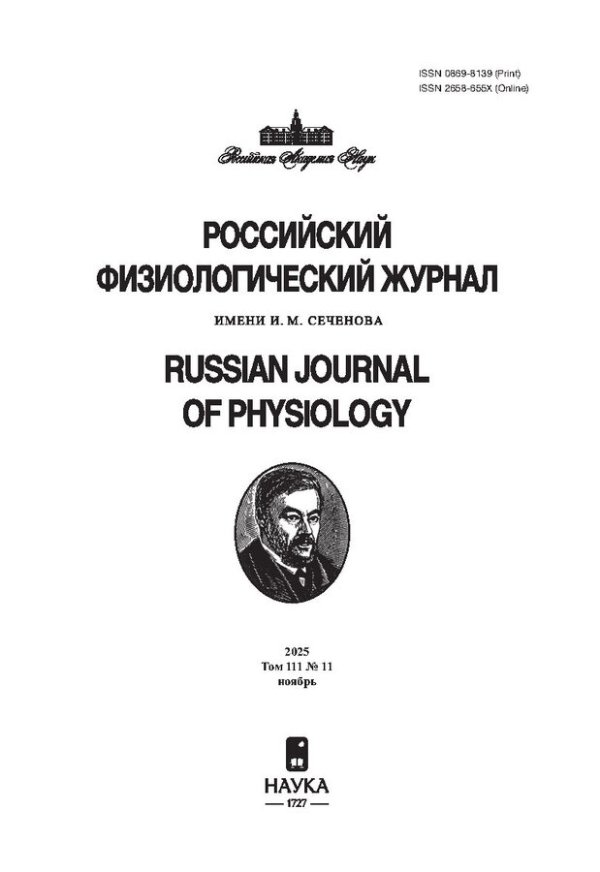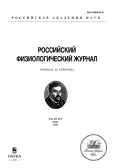THE ROLE OF GABA RECEPTORS IN SEIZURE DEVELOPMENT WHEN BREATHING HYPERBARIC OXYGEN
- Authors: Alekseeva O.S.1, Platonova T.F.1, Demchenko I.T.1
-
Affiliations:
- Sechenov Institute of Evolutionary Physiology and Biochemistry of the Russian Academy of Sciences
- Issue: Vol 111, No 6 (2025)
- Pages: 944-956
- Section: EXPERIMENTAL ARTICLES
- URL: https://bakhtiniada.ru/0869-8139/article/view/304818
- DOI: https://doi.org/10.31857/S0869813925060083
- EDN: https://elibrary.ru/teqxks
- ID: 304818
Cite item
Abstract
The use of hyperbaric oxygen (HBO2) in medicine and in underwater diving is associated with the risk of its toxic (convulsant) effect on the central nervous system, the pathophysiological mechanisms of which have not been sufficiently studied. A common hypothesis about the mechanism of HBO2-induced convulsions is the idea that extreme hyperoxia suppresses GABAergic function with subsequent increase in CNS excitation, leading to convulsions. The deficit of GABAergic function in HBO2 is due to a decrease in the synthesis of the mediator, while the involvement of other components of inhibitory neurotransmission, in particular, GABA receptors, remains unclear. The aim of this work was to study the involvement of GABA receptors in the development of hyperbaric oxygen convulsions. In the course of the work, motor convulsions in HBO2 were assessed in rats that were injected with GABA receptor agonists: muscimol or baclofen into the lateral ventricle of the brain before hyperoxic exposure. The affinity of GABA receptors to these drugs was also assessed against the background of an increased level of cerebral GABA caused by intraventricular administration of nipecotic acid. New data from the studies are: (a) activation of GABA-A receptors with muscimol delayed the onset of seizures in HBO2, (b) the GABA-B receptor agonist baclofen weakened the development of hyperbaric oxygen seizures, but its anticonvulsant effect was reliably lower than that of muscimol, (c) the anticonvulsant efficacy of muscimol and baclofen was preserved with an increase in extracellular GABA caused by inhibition of GABA transporters with nipecotic acid. The affinity of GABA-A and GABA-B receptors to the inhibitory neurotransmitter did not change under conditions of hyperbaric hyperoxia.
About the authors
O. S. Alekseeva
Sechenov Institute of Evolutionary Physiology and Biochemistry of the Russian Academy of Sciences
Email: osa72@inbox.ru
St. Petersburg, Russia
T. F. Platonova
Sechenov Institute of Evolutionary Physiology and Biochemistry of the Russian Academy of Sciences
Email: osa72@inbox.ru
St. Petersburg, Russia
I. T. Demchenko
Sechenov Institute of Evolutionary Physiology and Biochemistry of the Russian Academy of Sciences
Author for correspondence.
Email: osa72@inbox.ru
St. Petersburg, Russia
References
- Dean JB, Mulkey DK, Garcia AJ, Putnam RW, Henderson RA (2003) Neuronal sensitivity to hyperoxia, hypercapnia, and inert gases at hyperbaric pressures. J Appl Physiol (1985) 95(3): 883–909. https://doi.org/10.1152/japplphysiol.00920.2002
- D'Agostino DP, Putnam RW, Dean JB (2007) Superoxide (*O2-) production in CA1 neurons of rat hippocampal slices exposed to graded levels of oxygen. J Neurophysiol 98(2): 1030–1041. https://doi.org/10.1152/jn.01003.2006
- Demchenko IT, Boso AE, Whorton AR, Piantadosi CA (2001) Nitric oxide production is enhanced in rat brain before oxygen-induced convulsions. Brain Res 917(2): 253–261. https://doi.org/10.1016/s0006-8993 (01)03057-8
- Zhang S, Takeda Y, Hagioka S, Takata K, Aoe H, Nakatsuka H, Yokoyama M, Morita K (2005) Measurement of GABA and glutamate in vivo levels with high sensitivity and frequency. Brain Res Brain Res Protoc 14(2): 61–66. https://doi.org/10.1016/j.brainresprot.2004.03.005
- Кричевская АА, Шугалей ВС, Щербина ЛА, Ермоленко ГГ (1974) Содержание γ-аминомасляной кислоты и активность глютаматдекарбоксилазы в мозге крыс при гипербарической оксигенации и защитном действии мочевины. Вопр мед хим 20(3): 294–298. [Krichevskaya AA, Shugaley VS, Shcherbina LA, Ermolenko GG (1974) The content of γ-aminobutyric acid and the activity of glutamate decarboxylase in the brain of rats under hyperbaric oxygen and the protective action of urea. Vopr Med Chem 20(3): 294–298. (In Russ)].
- Щербакова ГВ (1962) Активность глютаматдекарбоксилазы и содержание γ-аминомасляной кислоты в мозге крыс при разных функциональных состояниях, вызванных повышенным давлением кислорода. Докл АН СССР 146(5): 1213–1215. [Shcherbakova GV (1962) Glutamate decarboxylase activity and γ-aminobutyric acid content in rat brain at different functional states caused by high oxygen pressure. Dokl AN USSR 146(5): 1213–1215. (In Russ)].
- Mialon P, Gibey R, Bigot JC, Barthelemy L (1992) Changes in striatal and cortical amino acid and ammonia levels of rat brain after one hyperbaric oxygen-induced seizures. Aviat Space Environ Med 63(4): 287–291.
- Singh AK, Banister EW (1978) Effect of 6-hydroxydopamine on brain and blood catecholamine, ammonia, and amino acid metabolism in rats subjected to high pressure oxygen induced convulsions. Can J Physiol Pharmacol 56(2): 334–336. https://doi.org/10.1139/y78-051
- Gasier HG, Demchenko IT, Tatro LG, Piantadosi CA (2017) S-nitrosylation of GAD65 is implicated in decreased GAD activity and oxygen-induced seizures. Neurosci Lett 653: 283–287. https://doi.org/10.1016/j.neulet.2017.05.067
- Beltrán González AN, López Pazos MI, Calvo DJ (2020) Reactive Oxygen Species in the Regulation of the GABA Mediated Inhibitory Neurotransmission. Neuroscience 15(439): 137–145. https://doi.org/10.1016/j.neuroscience.2019.05.064
- Paxinos G, Watson C (2005) The Rat Brain in Stereotaxic coordinates. Boston. MA. Elsevier.
- Moskvin AN, Platonova TP, Zhilyaev SY, Alekseeva OS, Nikitina ER, Demchenko IT (2020) Blockade Of γ-Aminobutyric Acid Transporters in Brain Synapses Protects Against Hyperbaric Oxygen-Induced Convulsions. Neurosci Behav Physiol 50: 505–510. https://doi.org/10.1007/s11055-020-00930-1
- Gernert M, Löscher W (2001) Lack of robust anticonvulsant effects of muscimol microinfusions in the anterior substantia nigra of kindled rats. Eur J Pharm 432: 35–41. https://doi.org/10.1016/S0014-2999(01)01458-3
- Mares P, Lindovský J, Slamberová R, Kubová H (2007) Effects of a GABA-B receptor agonist baclofen on cortical epileptic afterdischarges in rats. Epileptic Disord 1: S44–S51. https://doi.org/10.1684/epd.2007.0151
- Racine RJ (1972) Modification of seizure activity by electrical stimulation. II. Motor seizure. Electroencephal Clin Neurophysiol 32 (3): 281–294. https://doi.org/10.1016/0013-4694(72)90177-0
- Зальцман ГЛ (1968) Стадии развития кислородной эпилепсии и функциональное состояние нервной системы. В кн: Гипербарические эпилепсия и наркоз. ГЛ Зальцман (ред) Л. Наука. [GL Zaltsman (1968) Stages of formation of oxygen epilepsy and the functional state of the centres of the nervous system. In: Hyperbaric epilepsy and narcosis. Zaltsman GL (ed) Leningrad. Nauka. (In Russ)].
- Demchenko IT, Piantadosi CA (2006) Nitric oxide amplifies the excitatory to inhibitory neurotransmitter imbalance accelerating oxygen seizures. Undersea Hyperb Med 33(3): 169–174.
- Demchenko IT, Suliman HB, Zhilyaey SY, Alekseeva OS, Platonova TF, Makowski MS, Piantadosi CA, Gasier HG (2023) GAT inhibition preserves cerebral blood flow and reduces oxidant damage to mitochondria in rodents exposed to extreme hyperbaric oxygen. Front Mol Neurosci 15: 1062410. https://doi.org/10.3389/fnmol.2022.1062410
- Bean JW, Zee D, Thom B (1966) Pulmonary changes with convulsions induced by drugs and oxygen at high pressure. J Appl Physiol 21(3): 865–872. https://doi.org/10.1152/jappl.1966.21.3.865
- Fattore L, Cossu G, Martellotta MC, Deiana S, Fratta W (2001) Baclofen antagonises intravenous self-administration of gamma-hydroxybutyric acid in mice. Neuroreport 12(10): 2243–2246. https://doi.org/10.1097/00001756-200107200-00039
- Fattore L, Cossu G, Martellotta MC, Fratta W (2002) Baclofen antagonizes intravenous self-administration of nicotine in mice and rats. Alcohol Alcohol 37(5): 495–498. https://doi.org/10.1093/alcalc/37.5.495
- Spano MS, Fattore L, Fratta W, Fadda P (2007) The GABAB receptor agonist baclofen prevents heroin-induced reinstatement of heroin-seeking behavior in rats. Neuropharmacology 52(7): 1555–1562. https://doi.org/10.1016/j.neuropharm.2007.02.012
- Gorsane MA, Kebir O, Hache G, Blecha L, Aubin HJ, Reynaud M, Benyamina A (2012) Is baclofen a revolutionary medication in alcohol addiction management? Review and recent updates. Subst Abus 33(4): 336–349. https://doi.org/10.1080/08897077.2012.663326
- Romanova OL, Chauhan M, Blagonravov ML, Kislov MA, Ershov AV, Krupin KN (2022) Baclofen (fun drug) and ethanol combined poisoning in humans: A histopathology and morphometry model. J Forensic Leg Med 90: 102373. https://doi.org/10.1016/j.jflm.2022.102373
- Shaye H, Stauch B, Gati C, Cherezov V (2021) Molecular mechanisms of metabotropic GABAB receptor function. Sci Adv 7(22): 1–15. https://doi.org/10.1126/sciadv.abg3362
- Gassmann M, Bettler B (2012) Regulation of neuronal GABA(B) receptor functions by subunit composition. Nat Rev Neurosci 13(6): 380–394. https://doi.org/10.1038/nrn3249
- Brown JW, Moeller A, Schmidt M, Turner SC, Nimmrich V, Ma J, Rueter LE, van der Kam E, Zhang M (2016) Anticonvulsant effects of structurally diverse GABA(B) positive allosteric modulators in the DBA/2J audiogenic seizure test: Comparison to baclofen and utility as a pharmacodynamic screening model. Neuropharmacology 101: 358–369. https://doi.org/10.1016/j.neuropharm.2015.10.009
- Collins RC (1980) Anticonvulsant effects of muscimol. Neurology 30(6): 575–581. https://doi.org/10.1212/wnl.30.6.575
- Sawamura А, Hashizume K, Yoshida K, Tanaka T (2001) Kainic acid-induced substantia nigra seizure in rats: Вehavior, EEG and metabolism. Brain Res 911(1): 89–95. https://doi.org/10.1016/s0006-8993(01)02732-9
- Enna SJ, Collins JF, Snyder SH (1977) Stereospecificity and structure-activity requirements of GABA receptor binding in rat brain. Brain Res 124(1): 185–190. https://doi.org/ 10.1016/0006-8993(77)90878-2
- Martin JH (1991) Autoradiographic estimation of the extent of reversible inactivation produced by microinjection of lidocaine and muscimol in the rat. Neurosci Lett 127(2): 160–164. https://doi.org/10.1016/0304-3940(91)90784-q
- Kubota K (1996) Motor cortical muscimol injection disrupts forelimb movement in freely moving monkeys. Neuroreport 7(14): 2379–2384. https://doi.org/10.1097/00001756-199610020-00020
- Hosford DA, Wang Y, Cao Z (1997) Differential effects mediated by GABAA receptors in thalamic nuclei in lh/lh model of absence seizures. Epilepsy Res 27(1): 55–65. https://doi.org/ 10.1016/s0920-1211(97)01023-1
- Shehab S, Simkins M, Dean P, Redgrave P (1996) Regional distribution of the anticonvulsant and behavioural effects of muscimol injected into the substantia nigra of rats. Eur J Neurosci 8(4): 749–757. https://doi.org/10.1111/j.1460-9568.1996.tb01260.x
- Baraldi M, Grandison L, Guidotti A (1979) Distribution and metabolism of muscimol in the brain and other tissues of the rat. Neuropharmacology 18(1): 57–62. https://doi.org/10.1016/0028-3908(79)90009-1
- Singh K, Kumar P, Bhatia R, Mehta V, Kumar B, Akhtar MJ (2022) Nipecotic acid as potential lead molecule for the development of GABA uptake inhibitors; structural insights and design strategies. Eur J Med Chem 234(15): 114269. https://doi.org/10.1016/j.ejmech.2022.114269
- Wood JD, Watson WJ (1962) Protective action of gamma-aminobutyric acid against oxygen toxicity. Nature 195: 296.
- Alekseeva OS, Gerda BA, Zhilyaeva AS, Demchenko IT (2023) Anticonvulsant Efficacy of Inhibition of Synaptic and Extrasynaptic GABA-Transporters in the Prevention of Hyperbaric Oxygen Seizures. J Evol Biochem Phys 59: 709–718. https://doi.org/10.1134/S0022093023030055
Supplementary files










